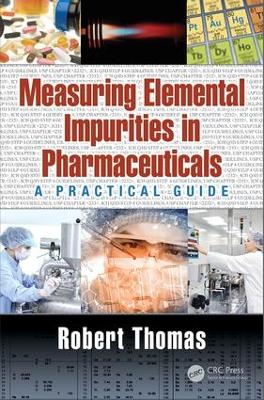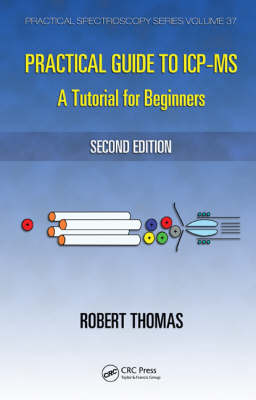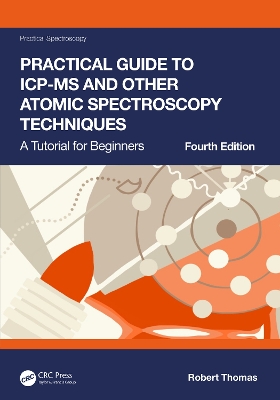Practical Spectroscopy
3 total works
Recent regulations on heavy metal testing have required the pharmaceutical industry to monitor a suite of elemental impurities in pharmaceutical raw materials, drug products and dietary supplements. These new directives s are described in the new United States Pharmacopeia (USP) Chapters 232>, 233>, and 2232>, together with Q3D, Step 4 guidelines for elemental impurities, drafted by the ICH (International Conference on Harmonization of Technical Requirements for Registration of Pharmaceuticals for Human Use), a consortium of global pharmaceutical associations, including the European Pharmacopeia (Ph.Eur.), the Japanese Pharmacopeia (JP) and the USP. This book provides a complete guide to the analytical methodology, instrumental techniques and sample preparation procedures used for measuring elemental impurities in pharmaceutical and nutraceutical materials.
It offers readers the tools to better understand plasma spectrochemistry to optimize detection capability for the full suite of elemental PDE (Permitted Daily Exposure) levels in the various drug delivery categories. Other relevant information covered in the book includes:
- The complete guide to measuring elemental impurities in pharmaceutical and nutraceutical materials.
- Covers heavy metals testing in the pharmaceutical industry from an historical perspective.
- Gives an overview of current USP Chapters 232> 233> and 2232> and ICH Q3D Step 4 Guidelines.
- Explains the purpose of validation protocols used in Chapter 233>, including how J-values are calculated
- Describes fundamental principles and practical capabilities of ICP-MS and ICP-OES.
- Offers guidelines about the optimum strategy for risk assessment
- Provides tips on how best to prepare and present your data for regulatory inspection.
An indispensable resource, the fundamental principles and practical benefits of ICP-OES and ICP-MS are covered in a reader-friendly format that a novice, who is carrying out elemental impurities testing in the pharmaceutical and nutraceutical communities, will find easy to understand.
Whatever your ICP-MS experience, you probably know that there are many textbooks compiled and edited by academics that approach ICP-MS from a purely theoretical and fundamental perspective, but there aren’t any books that provide a practical perspective of the technique that are written specifically for the novice user. You’ll be glad to know that the landscape is changing. With the publication of Practical Guide to ICP-MS: A Tutorial for Beginners, Second Edition, the user community has an new reference book that covers everything a beginner needs to know. Aimed specifically at analytical chemists who are not familiar with the technique and novice users who have just started using it, this updated, revised, and rewritten manuscript includes:
- Updated sections on ICP-MS basic principles to reflect advancements in the technology over the past four years
- New chapter on Trace Element Speciation using HPLC-ICP-MS
- New comprehensive easy-to-understand Glossary/dictionary of ICP-MS terms
- Extensive revisions to the chapter on "How to Select an ICP-MS"
- Applications section incorporates solutions to more and diverse application problems
- Rewritten chapter on collision/reaction cells and interfaces takes a detailed look at the different commercial approaches
- Updated chapter on alternative sample introduction techniques, including all the new commercially-available systems
- Revised chapter on comparing ICP-MS with other Atomic Spectroscopy techniques to reflect the most recent developments
Written by an insider with more than 20 years experience in product development, customer support, and technical marketing for an ICP-MS instrument vendor, the book highlights this powerful ultra trace-element technique as a practical solution to real-world problems. The in-depth presentation of analytical advantages and practical capabilities of the technique from someone who has been involved in all aspects of ICP-MS instrumental analysis, gives the author a unique insight into the technique and therefore makes the book an important part of any laboratory toolkit.
Practical Guide to ICP-MS and Other Atomic Spectroscopy Techniques
by Robert Thomas
Written by one of the very first practitioners of ICP-MS, Practical Guide to ICP-MS and Other Atomic Spectroscopy Techniques: A Tutorial for Beginners presents ICP-MS in a completely novel and refreshing way. By comparing it with other complementary atomic spectroscopy (AS) techniques, it gives the trace element analysis user community a glimpse into why the technique was first developed and how the application landscape has defined its use today, 40 years after it was first commercialized in 1983.
What’s new in the 4th edition:
- Updated chapters on the fundamental principles and applications of ICP-MS
- New chapters on complementary AS techniques including AA, AF, ICP-OES, MIP-AES, XRF, XRD, LIBS, LALI-TOFMS
- Strategies for reducing errors and contamination with plasma spectrochemical techniques
- Comparison of collision and reaction cells including triple/multi quad systems
- Novel approaches to sample digestion
- Alternative sample introduction accessories
- Comprehensive glossary of terms used in AS
- New vendor contact information
The book is not only suited to novices and beginners, but also to more experienced analytical scientists who want to know more about recent ICP-MS developments, and where the technique might be heading in the future. Furthermore, it offers much needed guidance on how best to evaluate commercial AS instrumentation and what might be the best technique, based on your lab’s specific application demands.
"I feel honored to have been asked to deliver the Foreword for this book, which is suited not only for beginners, but also for more experienced analytical scientists who want to know the advances in plasma spectrochemistry instrumentation and related future opportunities."
-Dr. Heidi Goenaga Infante, LGC Science Fellow; Chief Scientist, National Measurement Laboratory, Visiting Professor, University of Strathclyde, UK.


